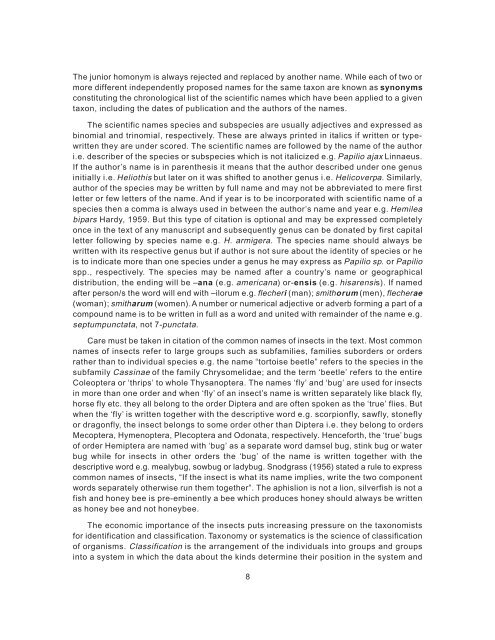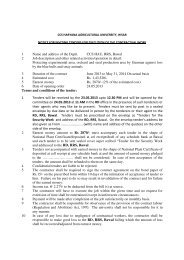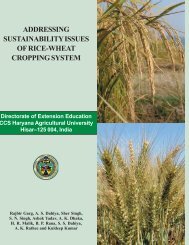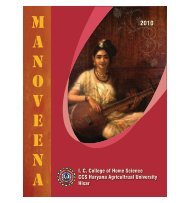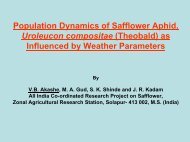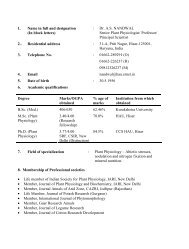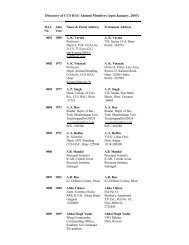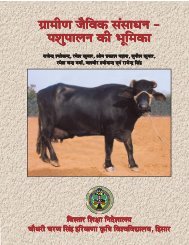Foreword - CCS HAU, Hisar
Foreword - CCS HAU, Hisar
Foreword - CCS HAU, Hisar
You also want an ePaper? Increase the reach of your titles
YUMPU automatically turns print PDFs into web optimized ePapers that Google loves.
The junior homonym is always rejected and replaced by another name. While each of two or<br />
more different independently proposed names for the same taxon are known as synonyms<br />
constituting the chronological list of the scientific names which have been applied to a given<br />
taxon, including the dates of publication and the authors of the names.<br />
The scientific names species and subspecies are usually adjectives and expressed as<br />
binomial and trinomial, respectively. These are always printed in italics if written or typewritten<br />
they are under scored. The scientific names are followed by the name of the author<br />
i.e. describer of the species or subspecies which is not italicized e.g. Papilio ajax Linnaeus.<br />
If the author’s name is in parenthesis it means that the author described under one genus<br />
initially i.e. Heliothis but later on it was shifted to another genus i.e. Helicoverpa. Similarly,<br />
author of the species may be written by full name and may not be abbreviated to mere first<br />
letter or few letters of the name. And if year is to be incorporated with scientific name of a<br />
species then a comma is always used in between the author’s name and year e.g. Hemilea<br />
bipars Hardy, 1959. But this type of citation is optional and may be expressed completely<br />
once in the text of any manuscript and subsequently genus can be donated by first capital<br />
letter following by species name e.g. H. armigera. The species name should always be<br />
written with its respective genus but if author is not sure about the identity of species or he<br />
is to indicate more than one species under a genus he may express as Papilio sp. or Papilio<br />
spp., respectively. The species may be named after a country’s name or geographical<br />
distribution, the ending will be –ana (e.g. americana) or-ensis (e.g. hisarensis). If named<br />
after person/s the word will end with –ilorum e.g. flecheri (man); smithorum (men), flecherae<br />
(woman); smitharum (women). A number or numerical adjective or adverb forming a part of a<br />
compound name is to be written in full as a word and united with remainder of the name e.g.<br />
septumpunctata, not 7-punctata.<br />
Care must be taken in citation of the common names of insects in the text. Most common<br />
names of insects refer to large groups such as subfamilies, families suborders or orders<br />
rather than to individual species e.g. the name “tortoise beetle” refers to the species in the<br />
subfamily Cassinae of the family Chrysomelidae; and the term ‘beetle’ refers to the entire<br />
Coleoptera or ‘thrips’ to whole Thysanoptera. The names ‘fly’ and ‘bug’ are used for insects<br />
in more than one order and when ‘fly’ of an insect’s name is written separately like black fly,<br />
horse fly etc. they all belong to the order Diptera and are often spoken as the ‘true’ flies. But<br />
when the ‘fly’ is written together with the descriptive word e.g. scorpionfly, sawfly, stonefly<br />
or dragonfly, the insect belongs to some order other than Diptera i.e. they belong to orders<br />
Mecoptera, Hymenoptera, Plecoptera and Odonata, respectively. Henceforth, the ‘true’ bugs<br />
of order Hemiptera are named with ‘bug’ as a separate word damsel bug, stink bug or water<br />
bug while for insects in other orders the ‘bug’ of the name is written together with the<br />
descriptive word e.g. mealybug, sowbug or ladybug. Snodgrass (1956) stated a rule to express<br />
common names of insects, “If the insect is what its name implies, write the two component<br />
words separately otherwise run them together”. The aphislion is not a lion, silverfish is not a<br />
fish and honey bee is pre-eminently a bee which produces honey should always be written<br />
as honey bee and not honeybee.<br />
The economic importance of the insects puts increasing pressure on the taxonomists<br />
for identification and classification. Taxonomy or systematics is the science of classification<br />
of organisms. Classification is the arrangement of the individuals into groups and groups<br />
into a system in which the data about the kinds determine their position in the system and<br />
8


